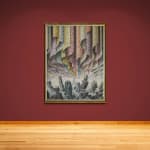-
Artworks
Henry Orlik b. 1947
TOMBSTONESAcrylic on canvasH. 169cm x W. 130cm; H. 66½in. x W. 51in.With artist's stamp versoWB2939Copyright The ArtistFurther images
Henry Orlik's monumental painting Tombstones emerges as one of the most spiritually resonant works from his transformative American period. Created during the artist's five-year sojourn in the United States, this...Henry Orlik's monumental painting Tombstones emerges as one of the most spiritually resonant works from his transformative American period. Created during the artist's five-year sojourn in the United States, this extraordinary canvas transforms conventional memorial imagery into a profound meditation on mortality, transformation, and cosmic forces. Orlik's revolutionary approach to painting not only elevates what might have been a sombre remembrance into a vibrant celebration of the eternal dance between matter and spirit but also inspires a new way of perceiving the world.
The work situates itself within the broader context of late twentieth-century spiritual abstraction, establishing connections with Neo-Expressionist investigations of the sacred while drawing from deeper philosophical wells. Where contemporary German artists excavated trauma through material accumulation, Orlik pursues what might be termed 'energetic synthesis', a technical approach that bridges Kandinsky's spiritual necessity with Rothko's chromatic elevation. This technique involves the use of vibrant colours and dynamic brushstrokes to create a sense of movement and energy on the canvas, anticipating subsequent developments in the studies of consciousness.
When Orlik arrived in America in 1980, he encountered a landscape that would fundamentally reshape his artistic vision. Initially settling in Los Angeles before his pivotal move to New York in 1981, he found himself surrounded by architectural forms that he described as pulsing with their fierce personalities, alive, imposing, and charged with electric energy. This documented tension between urban intensity and the need for contemplative space profoundly influenced his work, creating pieces that synthesise opposing forces within what can be understood as one of America's most transformative decades of internal exploration of the psyche.
The canvas presents a striking visual dichotomy operating on multiple interpretive levels, suggesting what Dante termed a polysemous structure, where meaning unfolds allegorically, morally, and analogically. The lower portion depicts dark, heavy memorial stones rendered in sombre greys and blacks, solid, earthbound forms representing what Orlik characterised as humanity's tendency toward being "drab, colourless and earthbound." Rising above these forms is an extraordinary display of vibrant vertical bands ascending toward unseen realms, pulsing with Orlik's signature "excitation" brushstrokes — thousands of minute, spiralled marks that he described as representing "universal energy, making canvases pulsate with kinetic vitality."
The technical execution reveals Orlik's mastery of what he termed his quantum-informed approach. Working with acrylic paint, he built the composition through layers of gestural underpainting followed by methodical application of his characteristic marks. Each brushstroke required what he called 'energetic alignment', a state where, as he observed, 'if tired one cannot imitate energy... or if angry one cannot make the lines tranquil. It has the sensitivity of a lie detector.' This approach, influenced by quantum physics, suggests that the act of painting can access and express fundamental energetic principles, creating shimmering optical effects when viewed from a distance and revealing individual gestures that seem to pulse with what quantum physicist David Bohm would later theorise as 'implicate order.'
The artist's development of Quantum Painting synthesises insights from Gary Zukav's The Dancing Wu Li Masters with his understanding of Chinese calligraphic traditions and medieval hermeneutic methods. This approach resonates with Maurice Merleau-Ponty's phenomenology of perception, where consciousness and matter interpenetrate in the act of creation. The technique anticipates aspects of contemporary consciousness research, suggesting that artistic practice might access fundamental quantum processes, though such connections remain interpretive rather than scientifically established.
The ascending forms invite interpretation through the ancient concept of musica universalis, the celestial harmony that medieval philosophers believed emerged from their understanding of planetary theory. The colour of the planet's complete forms rising above the memorial stones can be interpreted as musical notes or elements of a church organ, transforming the composition into what Orlik described as the 'music of the spheres', the harmony of the cosmos, of which earthly harmony or disharmony plays a crucial part. In this macrocosmic understanding, if the earth and humanity (each individual as microcosm) are out of balance, we unbalance the entire cosmos. As Orlik observed about artistic creation: 'Like music, if we reduce a symphony to the notes... we lose the music of the thing, the reality. In the same way, we lose the reality of the universe if we merely describe in quantitative terms the particles the universe is composed of.' Individual memorial stones represent discrete 'notes' of human existence while ascending energies suggest the symphonic whole that emerges when individual lives align with cosmic purpose.
The work functions within established iconographic traditions while radically updating their significance. The memento moritradition from medieval art finds new expression through quantum-informed aesthetics, while Jacob's Ladder motif, angels ascending between earth and heaven, transforms into pure energy streams. This iconographic innovation situates Orlik within the tradition of "spiritual abstraction," as identified by art historian Sixten Ringbom, where artists such as Hilma af Klint and Agnes Martin pursued elevated experiences through non-representational means.
35of 35
Join our mailing list
Be the first to hear about our upcoming exhibitions, events and news
* denotes required fields
We will process the personal data you have supplied to communicate with you in accordance with our Privacy Policy. You can unsubscribe or change your preferences at any time by clicking the link in our emails.






